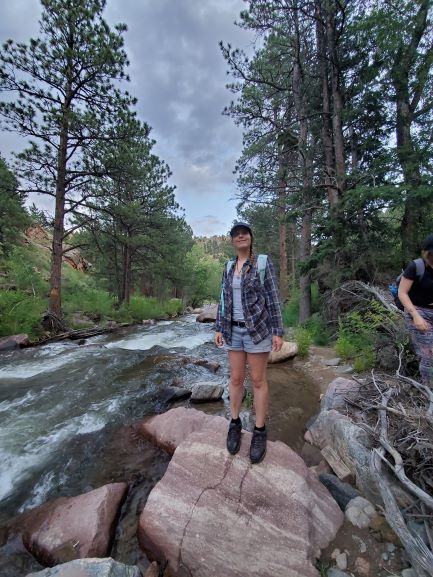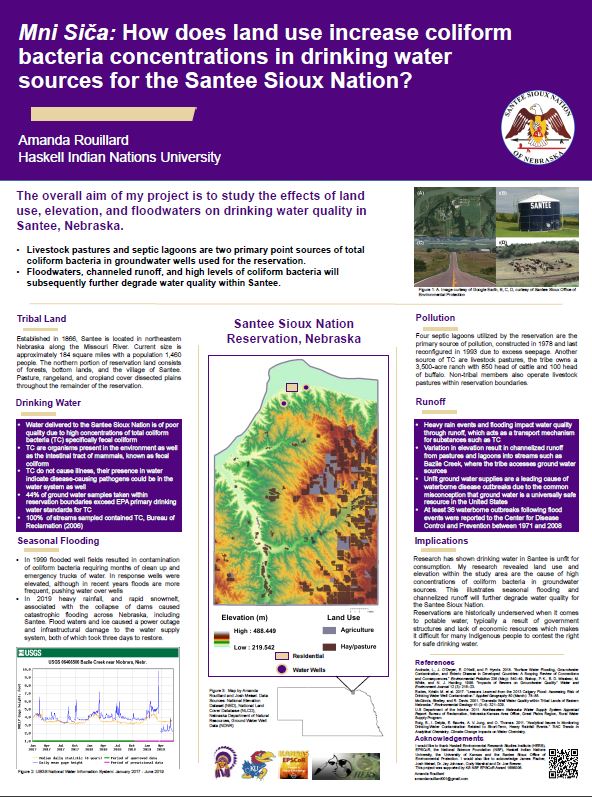


Amanda Rouillard always wanted to become a scientist, and she wanted to study the environment, soil health, plant ecosystems, natural resources, and most of all water quality. When she heard about the 2019 Haskell Environmental Research Studies (HERS) Institute and its focus on researching climate change and the environment, she knew she wanted to attend. Plus, joining the 2019 HERS cohort would give her the opportunity to meet other students interested in environmental related issues within the Native American community, gain fieldwork experience, and research her own tribe’s drinking water issues. The HERS internship program is one of the education initiatives supported by the Kansas NSF EPSCoR RII Track-1 Award OIA-1656006: Microbiomes of Aquatic, Plant, and Soil Systems across Kansas (MAPS). HERS is an eight week paid summer internship program where students spend six weeks on the Haskell Indian Nations University (HINU) campus learning about climate change and developing individual research projects. The program is under the direction of Dr. Jay Johnson, Professor and Associate Chair of Geography and Atmospheric Science and the Director of The Center for Indigenous Research, Science, and Technology (C-FIRST) at the University of Kansas (KU), and Mr. Cody Marshall, Indigenous and American Indian Studies faculty at HINU.
The title of Amanda’s research project was Patterns in land use, geography, and total coliform bacteria concentrations in drinking water sources for the Santee Sioux Nation. She said she picked this topic because “I grew up on the Santee Reservation without access to potable water sources, and I wanted to understand why.” The Santee Reservation is located near Niobrara, NE. She explained her project as follows: “The overall aim of my project was to study the patterns between land use, elevation, and floodwaters on the reservation and to investigate the impact of these patterns on the Santee Reservation drinking water. Livestock pastures and septic lagoons are two of the primary point-source coliform bacteria contributors, specifically fecal coliform, that pollute the groundwater wells used for drinking water on the reservation. Floodwaters, channelized runoff, and high concentrations of bacteria degrade these water sources. I compiled and analyzed environmental data involving well water quality, land characteristics, geographical features, and data from past flooding events. Reports from the United States Department of the Interior’s Bureau of Reclamation were used, which included background information about the Santee Sioux Nation, as well as data on water quality, septic systems, livestock, and agricultural practices within the reservation. Esri’s ArcGIS was used to access geospatial datasets to explore the geography of Santee Reservation and to create maps. Light detection and ranging (LIDAR) datasets were used to survey land-use and land cover. The United States Geological Survey (USGS) Water Information System was used to access data from specific water monitoring sites and to identify dates of the hydrologic events. This compilation of data was analyzed to form an overall view of the Santee Reservation’s water quality situation and to show how relationships between geography, land-use, and flooding impact the degradation of that water quality.” Amanda’s HERS mentor was Katrina McClure, Graduate Research Assistant for the Institute for Policy & Social Research, and Ph.D. student in the Department of Geography and Atmospheric Science at KU.
While participating in the HERS program, Amanda said she “learned a lot about scientific writing and the process of writing a research paper, as well as the importance of networking and meeting others within your area of study. I also was able to learn about graduate school and many other opportunities.” Her favorite part of the internship was “meeting and spending the summer with everyone involved within the internship, and having opportunities to travel to conferences and workshops.” Amanda presented her research at the HERS students poster session, the University Corporation for Atmospheric Research (UCAR) in Boulder Colorado, the summer KU Undergraduate Research Poster Session and again at the EPSCoR MAPS Research Symposium. As for the impact of her study, she added, “my most influential experience thus far was speaking and becoming a part of the 2019 Mini Ki Wakan: World Indigenous Peoples Water Summit in Rapid City South Dakota. This summit forms global and regional partnerships dedicated to the protection of Indigenous people’s rights to safe drinking water. Members are composed of elders, students, professionals, and storytellers who aim to use Indigenous knowledge to address water-related issues within the Native American Country.”
Amanda is a member of the Santee Sioux Nation and will be a senior this fall at HINU. She holds an associate’s degree in Natural Science with Cum Laude honors and is currently working towards a bachelor’s degree in environmental science. During the summers of her freshman and sophomore year, Amanda served as a research intern for a project that analyzed the impacts of the South Lawrence Traffic-way on the Haskell Wetlands. The following summer, she continued the internship and conducted a geospatial analysis of the newly formed Haskell and Baker Wetlands, focusing on altered waterways, water depths, and water quality.”
As for Amanda’s future plans, she will graduate in May 2021 and plans “to enter graduate school at Michigan State University to study in the Zarnetske Watershed Science Lab. My goal is to pursue a career in hydroecology to assist Indigenous peoples in developing solutions to water-related issues.”
